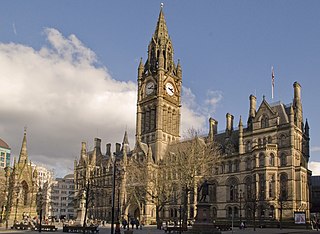
Salford is a city in Greater Manchester, England, situated on the western bank of the River Irwell which forms its boundary with Manchester city centre. Landmarks in the city include the former town hall, Salford Cathedral, Salford Lads' Club and St Philip's Church. In 2021 it had a population of 129,794. The demonym for people from Salford is Salfordian.

Manchester Town Hall is a Victorian, Neo-gothic municipal building in Manchester, England. It is the ceremonial headquarters of Manchester City Council and houses a number of local government departments. The building faces Albert Square to the north and St Peter's Square to the south, with Manchester Cenotaph facing its southern entrance.

Manchester Central Library is the headquarters of the city's library and information service in Manchester, England. Facing St Peter's Square, it was designed by E. Vincent Harris and constructed between 1930 and 1934. The form of the building, a columned portico attached to a rotunda domed structure, is loosely derived from the Pantheon, Rome. At its opening, one critic wrote, "This is the sort of thing which persuades one to believe in the perennial applicability of the Classical canon".

Salford Museum and Art Gallery, in Peel Park, Salford, Greater Manchester, opened to the public in November 1850 as the Royal Museum and Public Library. The gallery and museum are devoted to the history of Salford and Victorian art and architecture.

Pendlebury is a town in the City of Salford, Greater Manchester, England. The population at the 2011 Census was 13,069. It lies 4 miles (6 km) north-west of Manchester, 3 miles (5 km) north-west of Salford and 6 miles (10 km) south-east of Bolton.

Cheetham is an inner-city area and electoral ward of Manchester, in Greater Manchester, England, which in 2011 had a population of 22,562. It lies on the west bank of the River Irk, 1.4 miles (2.3 km) north of Manchester city centre, close to the boundary with Salford, bounded by Broughton to the north, Harpurhey to the east, and Piccadilly and Deansgate to the south.

The City of Manchester forms part of the metropolitan county of Greater Manchester, which had its county council abolished in 1986. Manchester consists of several districts, but these districts do not represent a tier of government.

Little Hulton is a suburb in the City of Salford, Greater Manchester, England, 3.4 miles (5.5 km) south of Bolton, 7 miles (11.3 km) northwest of Salford, and 9 miles (14.5 km) northwest of Manchester. Within the boundaries of the historic county of Lancashire, Little Hulton is bordered by Farnworth to the north, Walkden to the east and Tyldesley to the south.
The city of Leicester in England was policed independently until 1 April 1967 when its police force was merged with the Leicestershire and Rutland Constabulary to form the Leicester and Rutland Constabulary.

Richard Lane was an English architect of the early and mid-19th century. Born in London and based in Manchester, he was known mainly for his restrained and austere Greek-inspired classicism. He also designed a few buildings – mainly churches – in the Gothic style. He planned and designed many of the houses in the exclusive Victoria Park estate.
The Manchester City Police was, from the early 19th century until 1968, the territorial police force of the city of Manchester, in northern England.

St James Buildings is a high-rise, Grade II listed building on Oxford Street, Manchester, England, completed in 1912. The building was constructed in the Edwardian Baroque style and has a Portland stone exterior reaching a maximum height of 60m.

Manchester Town Hall Extension was built between 1934 and 1938 to provide additional accommodation for local government services. It was built between St Peter's Square and Lloyd Street in Manchester city centre, England. English Heritage designated it a grade II* listed building on 2 October 1974. Its eclectic style was designed to be a link between the ornate Gothic Revival Manchester Town Hall and the Classical architecture of the Central Library.

The Greater Manchester Police Museum is a former police station converted into a museum and archives detailing the history of policing in Greater Manchester, England. It was home to Manchester City Police and then its successors Manchester and Salford Police and Greater Manchester Police from 1879 until 1979.

The following is a timeline of the history of the city of Manchester in north west England.
St Michael's is a mixed-use redevelopment project in Jackson's Row in Manchester city centre, England, by Gary Neville's development company. It is to include two towers containing a hotel, flats, offices, a rooftop restaurant and a public square. First proposed in 2016, it began construction in 2022.
The Church of Our Lady and St Joseph, Heywood, is a Catholic church on Mary Street in Heywood, Greater Manchester, England and is a Grade II listed building.

George Noel Hill FRIBA, MTPI (1893–1985) was a British architect. He was the City Architect of Manchester and the Lancashire County Architect.

The Leicester City Police Headquarters is a historic building located in Leicester, England. It was built during 1931–33 as the headquarters of the Leicester City Police.















